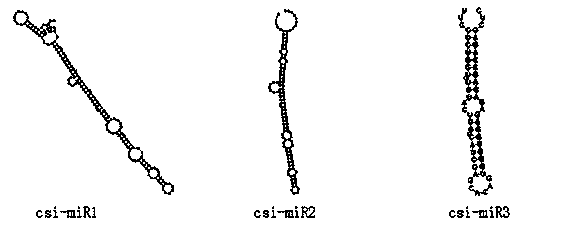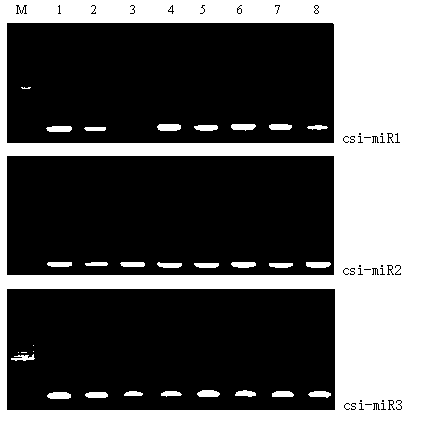Three microRNAs (ribose nucleic acids) from tea tree and application thereof
A technology of tea tree and nucleotide sequence, applied in the field of microRNA and its application, can solve the problem of extremely low detection abundance
Active Publication Date: 2014-05-28
ZHEJIANG ACAD OF MEDICAL SCI
View PDF1 Cites 0 Cited by
- Summary
- Abstract
- Description
- Claims
- Application Information
AI Technical Summary
Problems solved by technology
Since sodium periodate is a strong oxidizing agent, it can oxidize the 2' and 3' free hydroxyl groups of animal-derived miRNAs, resulting in the animal-derived miRNAs not being detected or detected in extremely low abundance during miRNA sequencing and qPCR
Method used
the structure of the environmentally friendly knitted fabric provided by the present invention; figure 2 Flow chart of the yarn wrapping machine for environmentally friendly knitted fabrics and storage devices; image 3 Is the parameter map of the yarn covering machine
View moreImage
Smart Image Click on the blue labels to locate them in the text.
Smart ImageViewing Examples
Examples
Experimental program
Comparison scheme
Effect test
Embodiment 1
Embodiment 2
Embodiment 3
the structure of the environmentally friendly knitted fabric provided by the present invention; figure 2 Flow chart of the yarn wrapping machine for environmentally friendly knitted fabrics and storage devices; image 3 Is the parameter map of the yarn covering machine
Login to View More PUM
 Login to View More
Login to View More Abstract
The invention discloses three microRNAs (ribose nucleic acids) from a tea tree and application thereof, belongs to the technical field of drugs, and provides three microRNA sequences and microRNA precursor sequences from the tea three as well as application thereof in treatment of tumor, diabetes mellitus, fatty liver and respiratory diseases.
Description
technical field The invention belongs to the technical field of medicines, and specifically relates to three microRNAs derived from tea trees and applications thereof. Background technique microRNA (miRNA) is a "star molecule" that has been studied more in recent years. Noncoding RNAs consisting of 18–25 nucleotides are first transcribed from the nuclear genome to form primary miRNAs (pri-miRNAs) with capped structures and polyadenosine tails. Pri-miRNA is treated with nuclease Drosha to form about 70 nt precursor miRNA (pre-miRNA) containing the stem link, which is then cleaved into mature miRNA by nuclease. miRNA binds to the 3'UTR sequence of target gene mRNA through incomplete base pairing, guides the silencing complex (RNA-induced silencing complex, RISC) to degrade mRNA or inhibits the translation of mRNA, thereby regulating gene expression. One miRNA can bind multiple target genes, and one mRNA can also be co-regulated by multiple miRNAs. This complex regulatory ne...
Claims
the structure of the environmentally friendly knitted fabric provided by the present invention; figure 2 Flow chart of the yarn wrapping machine for environmentally friendly knitted fabrics and storage devices; image 3 Is the parameter map of the yarn covering machine
Login to View More Application Information
Patent Timeline
 Login to View More
Login to View More IPC IPC(8): A61K48/00C12N15/11A61P35/00A61P3/10A61P1/16A61P11/00A61P31/00
Inventor 余陈欢应华忠钟宇森金晓音吕宇方杰
Owner ZHEJIANG ACAD OF MEDICAL SCI
Features
- R&D
- Intellectual Property
- Life Sciences
- Materials
- Tech Scout
Why Patsnap Eureka
- Unparalleled Data Quality
- Higher Quality Content
- 60% Fewer Hallucinations
Social media
Patsnap Eureka Blog
Learn More Browse by: Latest US Patents, China's latest patents, Technical Efficacy Thesaurus, Application Domain, Technology Topic, Popular Technical Reports.
© 2025 PatSnap. All rights reserved.Legal|Privacy policy|Modern Slavery Act Transparency Statement|Sitemap|About US| Contact US: help@patsnap.com



